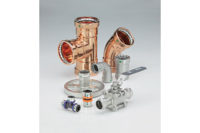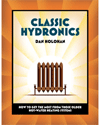May 8, 2007 - Industry Reacts To “Lead-Free Drinking Water Act”
Manufacturers cite lack of alternative
materials.
H.R. 2076, the “Lead-Free Drinking Water Act of 2007,” introduced April 30 by Rep. Eleanor Holmes Norton (D-DC) and Rep. Henry Waxman (D-CA), would ban all products that provide water for human ingestion (including water for bathing) that are not “lead-free” (defined by the bill as 0.2% lead or less) within five years after the bill’s introduction. “High-lead” products (greater than 2% lead) would be banned one year after the bill is enacted.
Both the 0.2% and 2% standards are drastic reductions from today’s 8% allowance. The 0.2% lead-free definition is even lower than California’s 0.25% standard, signed into law last year and slated to take effect in 2010.
Plumbing manufacturers have reacted to the bill with disappointment and frustration. They say they do not know how to make plumbing products with so little lead content at a price most people could afford. According to Barb Higgens, executive director of the Plumbing Manufacturers Institute, “There is no solution for getting the lead out immediately. There are expensive alternatives like stainless steel, but that brings faucets up into the $800-900 range, so there is no easy substitute.”
PMI is hosting a roundtable on May 31, 2007, in Chicago to explore the viability and the availability of other substitute alloys. PMI also has embarked on an information campaign explaining the dilemma to legislators both in Washington, D.C., and California to make sure these bills are properly interpreted “so that people understand there’s nothing to fear from your faucets,” says Higgens. “Our mission now is to make sure that people understand how lead is used in plumbing products, and that’s really where the problem begins. What we need to make understood is that these products are highly regulated and very safe.”
As reported earlier, the bill would require the following:
H.R. 2076, the “Lead-Free Drinking Water Act of 2007,” introduced April 30 by Rep. Eleanor Holmes Norton (D-DC) and Rep. Henry Waxman (D-CA), would ban all products that provide water for human ingestion (including water for bathing) that are not “lead-free” (defined by the bill as 0.2% lead or less) within five years after the bill’s introduction. “High-lead” products (greater than 2% lead) would be banned one year after the bill is enacted.
Both the 0.2% and 2% standards are drastic reductions from today’s 8% allowance. The 0.2% lead-free definition is even lower than California’s 0.25% standard, signed into law last year and slated to take effect in 2010.
Plumbing manufacturers have reacted to the bill with disappointment and frustration. They say they do not know how to make plumbing products with so little lead content at a price most people could afford. According to Barb Higgens, executive director of the Plumbing Manufacturers Institute, “There is no solution for getting the lead out immediately. There are expensive alternatives like stainless steel, but that brings faucets up into the $800-900 range, so there is no easy substitute.”
PMI is hosting a roundtable on May 31, 2007, in Chicago to explore the viability and the availability of other substitute alloys. PMI also has embarked on an information campaign explaining the dilemma to legislators both in Washington, D.C., and California to make sure these bills are properly interpreted “so that people understand there’s nothing to fear from your faucets,” says Higgens. “Our mission now is to make sure that people understand how lead is used in plumbing products, and that’s really where the problem begins. What we need to make understood is that these products are highly regulated and very safe.”
As reported earlier, the bill would require the following:
- 1) Valid Testing. This bill
eliminates the loophole that allowed the D.C. Water and Sewer Authority (WASA)
to continue testing once it exceeded the 15 parts per billion (ppb) action
level. Instead, 10% of lead pipes must be replaced until all are eliminated.
2) Total Lead Service Line Replacement. Instead of replacing only publicly owned lead service lines, this bill requires total replacement, including the portion owned by the homeowner. Norton says the hearings showed that partial replacement can actually increase the amount of lead in drinking water, because the new metal, such as brass or copper, can interact with the remaining lead pipe and accelerate lead leaching into the drinking water.
3) Individual Notice From Detection to Correction. The bill requires notice to all customers individually within 30 days of lead exceedence, stating the scope of testing, results and corrective actions.
4) Alternative Water Supply. Where excessive lead is found, the bill requires that certified water filters be provided to each residence, school and day care facility.
5) Testing Water Treatment Chemicals. The bill requires water systems to have corrosion control plans within one year of switching chemical treatment or a finding of excessive lead in the water.
6) Lead Free Plumbing. “Lead free” in this bill is defined as 0.2%, the standard already used in Los Angeles, down from the current 8%. Norton reports that she heard testimony at the hearings that most brass and copper plumbing contains 8% lead.
7) Lead Testing In Schools. This bill requires the repair or replacement of school water coolers found to have excessive lead. Annual testing of water coolers in schools is also required.
Look for further updates to this story, as well as the PMI roundtable meeting on this website and in Plumbing & Mechanical, Supply House Times, and PM Engineer magazines.
Looking for a reprint of this article?
From high-res PDFs to custom plaques, order your copy today!







